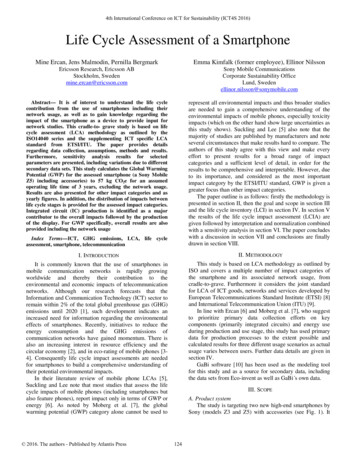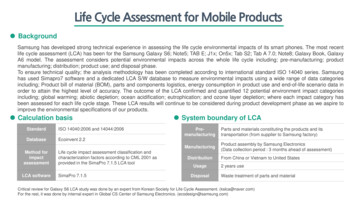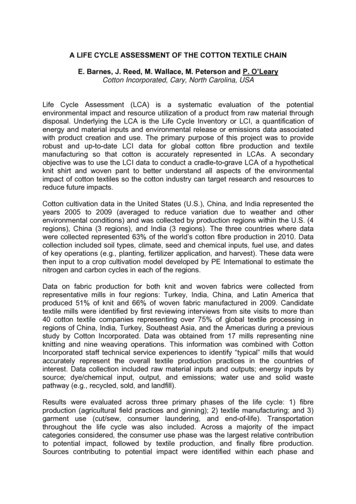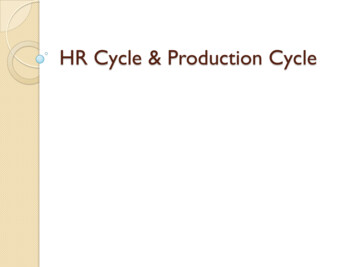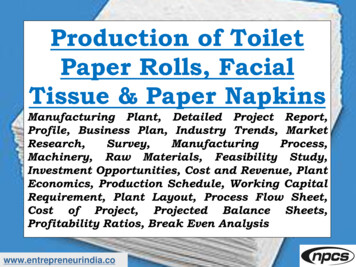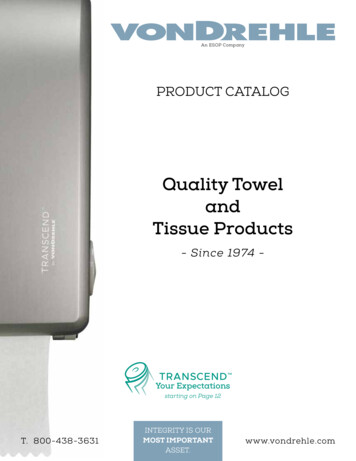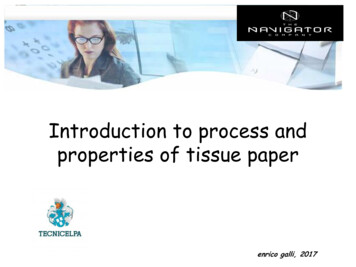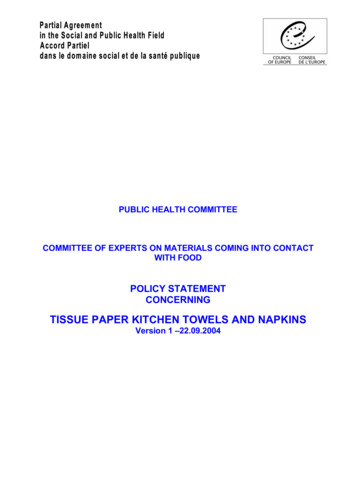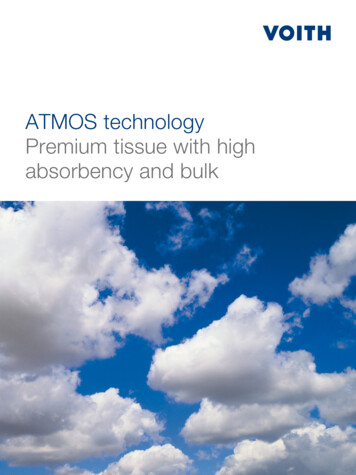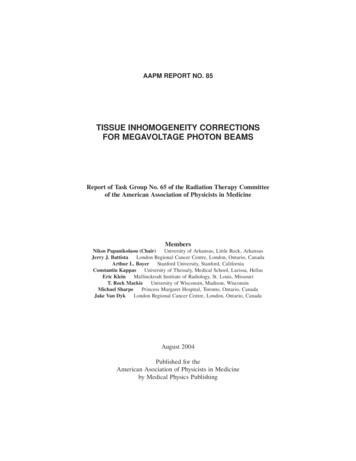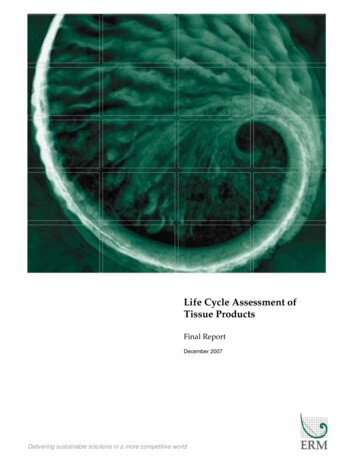
Transcription
Life Cycle Assessment ofTissue ProductsFinal ReportDecember 2007Delivering sustainable solutions in a more competitive world
Kimberly ClarkLife Cycle Assessment of TissueProductsFinal ReportDecember 2007Prepared by Jacob MadsenFor and on behalf ofEnvironmental Resources ManagementApproved by: Simon AumonierSigned:Position: PartnerDate: 7th December 2007This report has been prepared by Environmental ResourcesManagement the trading name of Environmental ResourcesManagement Limited, with all reasonable skill, care and diligencewithin the terms of the Contract with the client, incorporating ourGeneral Terms and Conditions of Business and taking account of theresources devoted to it by agreement with the client.We disclaim any responsibility to the client and others in respect ofany matters outside the scope of the above.This report is confidential to the client and we accept no responsibilityof whatsoever nature to third parties to whom this report, or any partthereof, is made known. Any such party relies on the report at theirown risk.
CONTENTS1INTRODUCTION11.11.2PROJECT BACKGROUNDLIFE CYCLE ASSESSMENT122GOAL AND .82.2.92.2.102.2.112.2.122.2.132.2.142.2.15GOAL DEFINITIONSCOPE OF THE STUDYFunctions of the product systemFunctional unitsSystem boundariesProduct systems studiedModelling of what-if scenariosData categoriesCut-off criteria for initial inclusion of inputs and outputsData requirementsData quality requirementsInventory analysisImpact assessment methodInterpretationReportingCritical review considerationsModifications to the initial scope333471217171718191920222222233INVENTORY 1.83.1.93.1.103.2INVENTORY ANALYSISIntroductionForestryVirgin pulp productionWaste paper collection and recoveryMarket de-inked pulp (MDIP) productionTissue productionRetail and consumptionWaste managementTransportEnergyBURDEN ANALYSIS2424252831323338394244464IMPACT ASSESSMENT734.14.24.34.44.5PRODUCT 1 – NORTH AMERICAN BATHROOM TISSUEPRODUCT 2 – NORTH AMERICAN WASHROOM TOWELPRODUCT 3 – NORTH AMERICAN FACIAL TISSUEPRODUCT 4 – NORTH AMERICAN KITCHEN TOWELPRODUCT 5 – EUROPEAN FOLDED TOILET TISSUE7376798184
4.64.74.8PRODUCT 6 – EUROPEAN ROLL TOILET TISSUEPRODUCT 7 – EUROPEAN COMMERCIAL WIPERSNORMALISATION8789925LIFE CYCLE DS ACROSS THE PRODUCT COMPARISONSMEANINGFUL DIFFERENCE IN ENVIRONMENTAL IMPACTMEANINGFUL DIFFERENCE IN GLOBAL WARMING POTENTIALSENSITIVITY ANALYSISDETAILED ASSESSMENT OF SELECTED PRODUCT SYSTEMS949598991001086CONCLUSION111Annex AAnnex BAnnex CCML Impact Assessment MethodCritical ReviewGlossary
1INTRODUCTION1.1PROJECT BACKGROUNDKimberly-Clark (K-C) is a leading global health and hygiene company withoperations in 37 countries, products sold in more than 150 countries and over56,000 employees worldwide. K-C tissue products help to ensure health,hygiene, and well-being at home (e.g. facial tissues, bathroom tissue andpaper towel) and away from home (e.g. hand towels, wipers and washroomproducts. These tissue products contain virgin wood fibre, fibres derivedfrom paper recycling operations or a combination of the two. The use ofrecycled material in K-C products is driven by a long standing commitment tomake the best use of all available resources that balance the sometimescompeting business requirements of responding to customer and consumermandates, expectations and perceptions that recycled materials offerenvironmental benefits, meeting product performance requirements in ahighly competitive market and controlling raw material costs to maintainprofit margins. When not using recycled fibre, K-C’s stated goal is topurchase all of its fibre from suppliers certified to one of five forestcertification schemes with preference for wood fibre certified under the ForestStewardship Council (FSC) standard where FSC fibre is available and meetsproduct performance requirements and competitive market solutions. Again,this goal is designed to deliver the best use of available resources and respondto perceived environmental benefits. As part of its continuing fibrepurchasing and policy evaluations, K-C is interested in developing a morecomplete understanding of the environmental performance of tissue productscontaining responsibly managed virgin and recycled fibres.This project is a continuation of K-C’s historic leadership in the application ofsound environmental science in decision making. Development anddemonstration of Life Cycle Assessment (LCA) methods at K-C began in theearly 1990s with Scott Paper representatives attending initial SETAC meetingson the codification of LCA and conducting a series of demonstration projects.Currently, K-C LCA efforts are focused on integrating environmentalinformation into the product development process as part of the Vision 2010Design for Environment programme.This study will maintain the highest scientific standards for the practice ofLCA (as established in the ISO 14040 series documents) consistent withdelivering to internal decision makers reliable product insights whileproviding for the possible external communication of results. Therefore,Environmental Resource Management Limited (ERM) has been retained by KC to perform the study and independent critical review by a panel of expertswill take place throughout the project.ENVIRONMENTAL RESOURCES MANAGEMENTKIMBERLY CLARK1
1.2LIFE CYCLE ASSESSMENTThe international standard for Life Cycle Assessment, ISO14040 (ISO, 1997),states that: “LCA is a technique for assessing the environmental aspects and potentialimpacts associated with a product by: compiling an inventory of relevant inputs and outputs of a product system;evaluating the potential environmental impacts associated with those inputs andoutputs; andinterpreting the results of the inventory analysis and impact assessment phases inrelation to the objectives of the study.”LCA studies the environmental aspects and potential impacts throughout aproduct’s life (ie from cradle to grave), from raw material acquisition throughproduction, use and disposal. The general impacts needing considerationinclude resource use, human health, and ecological consequences.The key elements of an LCA are: goal and scope; life cycle inventory analysis; life cycle impact assessment; life cycle interpretation; reporting; and critical review.ENVIRONMENTAL RESOURCES MANAGEMENTKIMBERLY CLARK2
2GOAL AND SCOPE2.1GOAL DEFINITIONThe goal of this study was to determine the environmental performance oftissue products manufactured by K-C and the environmental trade-offsassociated with the use of virgin fibres and recycled fibres in tissue products.A differentiation between markets (home and business), as well as betweenNorth America and Europe, provides for a greater variation in the use ofrecycled fibres. The inclusion of both consumer and away from homeproducts, as well as the European and North American markets providesvariation in product market conditions, product designs (and design goals),recycling infrastructure and utility infrastructure. Overall, we believe thisscope will result in a more complete understanding of the trade-off in fibreselections.The results of the studies of European (EU 25) and the North Americanproducts were reported separately. Table 2.1 details the tissue products understudy and their geographical distribution. A presentation of the products andtheir functions is detailed in section 2.2.2.Table 2.1Geographical distribution of the tissue paper under studyNorth America (NA)Europe (EUR)Bathroom tissueWashroom towelFacial tissueKitchen towelFolded toilet tissueRoll toilet tissueCommercial wipersStandard product names are used to refer to the products listed in Table 2.1.These names reflect the cultural norms and practices in the country of sales.In North America, rolled tissue products for use in perineal wiping arecommonly referred to as bathroom tissue. In Europe, these products arecalled toilet tissue. The European toilet tissue market also includes foldedsheet products.As the study will be used externally, it will undergo critical review by anexternal review panel in accordance with the ISO standard on LCA.2.2SCOPE OF THE STUDY2.2.1Functions of the product systemWhen assessing different products, it is important that the functions of thedifferent product systems are equivalent, in order to allow clear interpretationENVIRONMENTAL RESOURCES MANAGEMENTKIMBERLY CLARK3
of the results. The function of tissue paper is manifold and normallyseparated into primary and secondary functions.Primary functions include: hygiene; absorbency; strength; and softness.Secondary functions include: image; luxury; quality; and consumer satisfaction.The product systems selected for the study are based on their relative interestto KC businesses. All products are either currently produced, or sufficientdata are available on recent production, such that data collection requirementscan be supported from manufacturing experience.2.2.2Functional unitsThe functional units defined below capture the primary functions of the tissuepaper types by referring to a specific type of product.In the study, secondary functions as listed above were taken intoconsideration in the selection of products under study. Whenever possible,the products studied were selected based on their ability to providecomparable performance against both the primary and secondary functions.ENVIRONMENTAL RESOURCES MANAGEMENTKIMBERLY CLARK4
Table 2.2Functional UnitsNA Bathroom tissueNA Washroom towelNA Facial tissueNA Kitchen towelFunctional UnitOne year of bathroom use for alarge, pragmatic US householdwith multiple children ages 6-17.Reference flow40,000 sheets of regular/economybathroom tissueAdditional informationK-C market research suggests that large US households,especially those with multiple children between the agesof 6 and 17, tend to purchase bathroom tissue fromcategories considered ‘economy’ or ‘regular’. Thesehouseholds also tend to be heavy purchasers of bathroomtissue (defined as more than 40,000 sheets per year).Households in the heavy buyer category account for 66%of all bathroom tissue purchases nationally.One year of hand drying for 5072,000 linear feet (app. 22 km) of 8US office buildings frequently supply hard roll towels forworkers in a typical US commercial inch (approximately 20 cm) wideuse in hand drying. K-C market research suggests thatoffice washroom.hard roll toweltypical office workers visit the washroom three times perday using 1.5 towels ( 1.2 ft2 (0.11 m2)) per visit. Over a260 day year, this results in an average of 965 ft2 (89.8 m2)of towel use per employee.One year of boxed facial tissue use 5,600 sheets of premium facial tissue K-C market research suggests large households in thein a large, affluent household in theEastern US tend to fall into the super heavy purchasingEastern US.category, with more than 5,600 sheets of facial tissue peryear (likely due to the high occurrence of cold and flusymptoms). Purchasers in this category consume 77% ofall tissue sold. Affluent households tend to purchasemore heavily from the premium and higher product tiers.One year of surface cleaning and2,100 sheets of regular kitchen towel K-C market research suggests that households with threehealth and hygiene tasks in aor more members are more likely to show heavypragmatic US household with threeconsumption of paper towel (more than 2,100 sheets peror more total members.year). These households represent 79% of all paper towelsales volume. These consumers are likely to carefullyweigh their purchasing decisions to arrive at choices thatbalance performance and price.
Functional UnitOne year of office washroom useby 50 men and 50 women in animage conscious UK businessReference flow73,000 ft (22,250 m) of premiumfolded toilet tissueEUR Roll toilet tissueOne year of bathroom use in anaverage Dutch household160 rolls of common toilet tissue( 26,000 sheets)EUR Commercialwipers1000 kg of absorbed kitchen spills(750 kg water, 250 kg oil), over thecourse of one year in a hygieneconscious European chainrestaurant operation.68,000 product A centre fed rollwiper sheets, or82,000 Product B centre fed rollwiper sheetsEUR Folded toilettissueAdditional informationFor an image conscious establishment, the use of highquality toilet tissues is consistent with conveyingimportant business messages. This type of business islikely to purchase premium or super-premium toilettissue. K-C research suggests men and women tend touse washrooms at varying rates. On average, male officeemployees visit the washroom 2 times per day whilefemales visit 4.3 times per day. Average toilet tissue useper visit is 0.97 ft (app 0.3 m) per visit across bothgenders. Consistent with UK business practices, a workyear is considered 240 days.K-C market research suggests that Dutch householdshave a very pragmatic and rational approach to toilettissue purchases. Dutch households also tend topurchase higher volumes of toilet tissues, buying anaverage of 160 rolls per year compared to a NorthernEuropean average of 140.As is the case for kitchen towels, wipers are used forcleaning under both wet and dry conditions. Strengthwhen wet and dry, along with absorbency rate andcapacity, are all important factors in determining thequality of wiper products. Some customers require 100%virgin fibres for use in food service cleaning while othersdo not. Users of 100% virgin products are expected toexperience greater absorbency for both oil and water thanusers of 100% recycled fibre products. The difference inabsorbency causes the two different reference flows.
2.2.3System boundariesThe tissue paper systems investigated included all life cycle stages. All energyand materials used were traced back to the extraction of resources. Emissionsfrom each life cycle stage were quantified. Waste management processes wereincluded, and landfilli
paper towel) and away from home (e.g. hand towels, wipers and washroom products. These tissue products contain virgin wood fibre, fibres derived from paper

